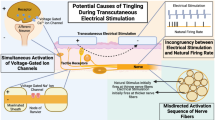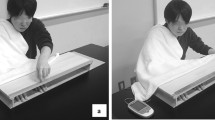Abstract
Previous studies have been unable to induce the Cutaneous Rabbit Effect (CRE) when the most likely perceived location of the illusory stimulus is on a non-continuous skin area. To determine whether the CRE could be elicited when each of the delivered stimuli were on non-continuous skin areas, we developed a new electrotactile stimulation paradigm attempting to induce the CRE across the fingertips. Though our stimulation paradigm differed from classic reduced CRE paradigms through the use of electrotactile stimuli, focusing the subject attention to a ‘likely’ illusory site, and the inclusion of a fourth stimulation site (two stimuli after the illusory stimulus), these factors were not the cause of the illusory effect we observed. Experiments conducted on the forearm validated that our paradigm elicited similar results to those reported in previous CRE studies that used either 3-stimulation-point mechanical or electrotactile stimuli with subject attention focused on the ‘likely’ illusory site. Across the fingertips, we observed an increase in stimulus mislocalization onto the middle fingertip, the ‘likely’ perceived location of the illusory stimuli, under Illusory Rabbit Trains compared to the Motion Bias Trains. Because the Motion Bias Trains should not induce a perceived location shift of the illusory stimulus but stimulates the adjacent digits in a similar way to the Illusory Rabbit Trains, differences observed between their mislocalization rates between these trains indicate that the CRE can be induced across the fingertips. These results provide the first evidence that the CRE can ‘jump’ when the stimuli occur across non-continuous skin areas.



Similar content being viewed by others
References
Blankenburg F, Ruben J, Meyer R, Schwiemann J, Villringer A (2003) Evidence for a rostral-to-caudal somatotopic organization in human primary somatosensory cortex with mirror-reversal in areas 3b and 1. Cereb Cortex 13:987–993
Blankenburg F, Ruff CC, Deichmann R, Rees G, Driver J (2006) The cutaneous rabbit illusion affects human primary sensory cortex somatotopically. Plos Biology 4:459–466
Chen LM, Friedman RM, Roe AW (2003) Optical imaging of a tactile illusion in area 3b of the primary somatosensory cortex. Science 302:881–885
Cholewiak RW (1976) Satiation in cutaneous saltation. Sens Process 1:163–175
Cholewiak RW (1999) The perception of tactile distance: influences of body site, space, and time. Perception 28:851–875
Eimer M, Forster B, Vibell J (2005) Cutaneous saltation within and across arms: a new measure of the saltation illusion in somatosensation. Percept Psychophys 67:458–468
Flach R, Haggard P (2006) The cutaneous rabbit revisited. J Exp Psychol Hum Percept Perform 32:717–732
Geldard FA (1977) Cutaneous stimuli, vibratory and saltatory. J Invest Dermatol 69:83–87
Geldard FA (1980) Cutaneous saltatory areas and intensity. Bull Psychon Soc 16:178
Geldard FA (1981) Saltatory areas of the skin—what determines their limits. Bull Psychon Soc 18:55
Geldard FA (1982a) Intersensory perception and sensory integration—walk, Rd, Pick, Hl. Am J Psychol 95:529–530
Geldard FA (1982b) Saltation in somesthesis. Psychol Bull 92:136–175
Geldard FA, Sherrick CE (1972) Cutaneous rabbit—perceptual illusion. Science 178:178
Geldard FA, Sherrick CE (1983) The cutaneous saltatory area and its presumed neural basis. Percept Psychophys 33:299–304
Goldreich D (2007) A bayesian perceptual model replicates the cutaneous rabbit and other spatiotemporal illusions. In: PLos One, p e333
Kilgard MP, Merzenich MM (1995) Anticipated stimuli across skin. Nature 373:663
Miyazaki M, Hirashima M, Nozaki D (2010) The “Cutaneous Rabbit” hopping out of the body. J Neurosci 30:1856–1860
Montgomery DC (2009) Design and analysis of experiments. Wiley, Hoboken
Naito E, Roland PE, Whrsson HH (2002) I feel my hand moving: a new role of the primary motor cortex in somatic perception of limb movement. Neuron 35:979–988
Schweizer R, Maier M, Braun C, Birbaumer N (2000) Distribution of mislocalizations of tactile stimuli on the fingers of the human hand. Somatosens Mot Res 17:309–316
Schweizer R, Braun C, Fromm C, Wilms A, Birbaumer N (2001) The distribution of mislocalizations across fingers demonstrates training-induced neuroplastic changes in somatosensory cortex. Exp Brain Res 139:435–442
Schweizer R, Voit D, Frahm J (2008) Finger representations in human primary somatosensory cortex as revealed by high-resolution functional MRI of tactile stimulation. Neuroimage 42:28–35
Warren JP, Bobich LR, Santello M, Sweeney JD, Helms Tillery SI (2008) Receptive field characteristics under electrotactile stimulation of the fingertip. Ieee Trans Neural Syst Rehabil Eng 16:410–415
Warren JP, Santello M, Helms Tillery SI (2009) Electrotactile inducement of the Cutaneous Rabbit Effect (CRE) across human fingertips. University of California System-wide Bioengineering Symposium, Merced
Weinstein S (1968) Intensive and extensive aspects of tactile sensitivity as a function of body part, sex and laterality. In: Kenshalo DR (ed) The skin senses. Charles L. Thomas, Springfield, pp 195–222
Acknowledgments
The authors would like to thank the members of the SensoriMotor Research Group and the Neural Control of Movement Laboratory at Arizona State University for their aid in designing the experimental protocol. This research was funded by the National Institute of Health, R01 NS050256.
Author information
Authors and Affiliations
Corresponding author
Rights and permissions
About this article
Cite this article
Warren, J.P., Santello, M. & Helms Tillery, S.I. Electrotactile stimuli delivered across fingertips inducing the Cutaneous Rabbit Effect. Exp Brain Res 206, 419–426 (2010). https://doi.org/10.1007/s00221-010-2422-0
Received:
Accepted:
Published:
Issue Date:
DOI: https://doi.org/10.1007/s00221-010-2422-0




